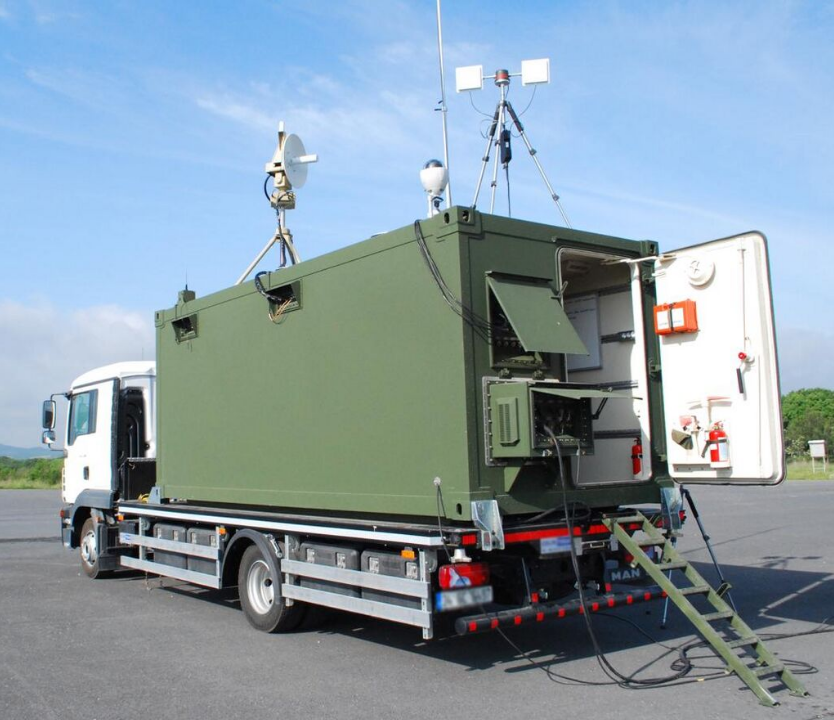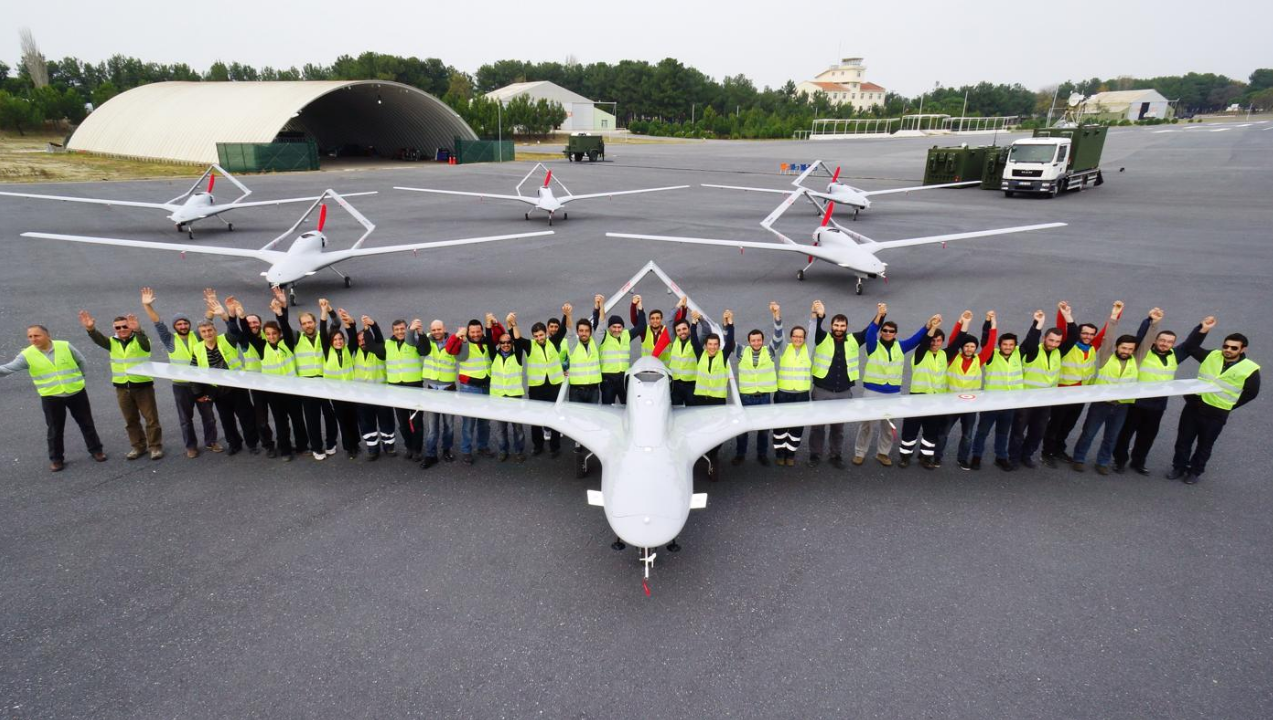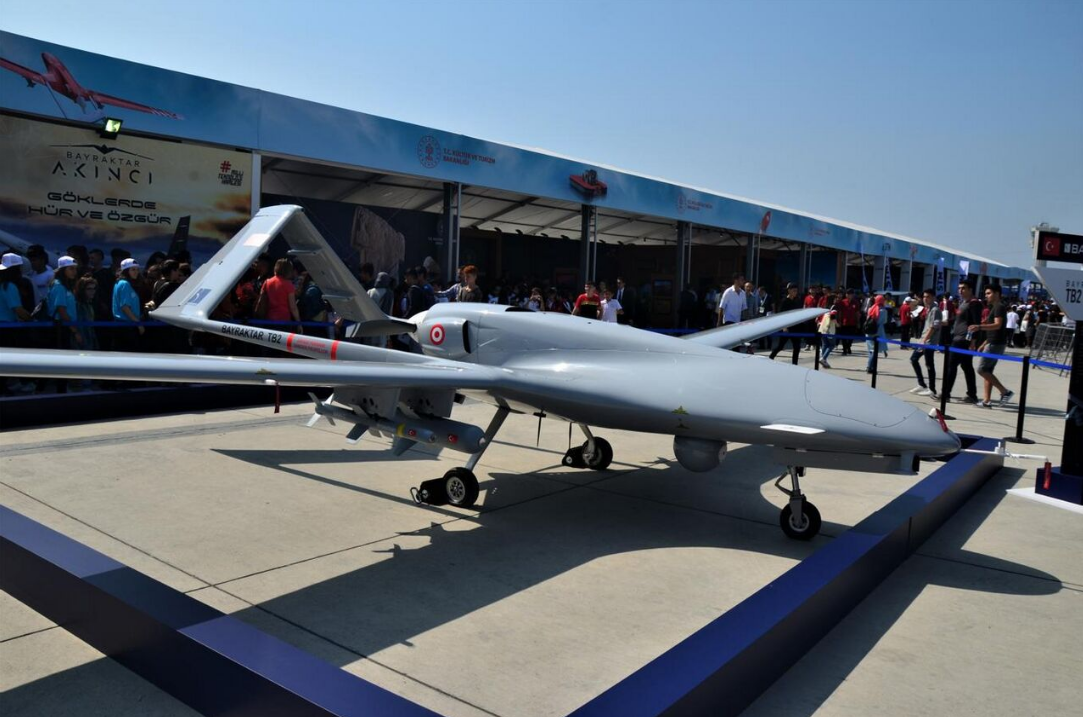
| Version | Summary | Created by | Modification | Content Size | Created at | Operation |
|---|---|---|---|---|---|---|
| 1 | Vivi Li | -- | 1707 | 2022-10-10 01:32:21 |
Video Upload Options
The Bayraktar Tactical UAS is a surveillance and reconnaissance unmanned aerial vehicle (UAV) initially developed for the Turkish Armed Forces. It is developed by the Kale-Baykar, a joint venture between the Kale Group and Baykar Technologies. In 2014, Bayraktar held the national endurance and altitude record for Turkey's unmanned aerial vehicles (UAV). It set a record for autonomous flight endurance when it flew 24 hours and 34 minutes at 18,000 feet on 5 August 2014. It furthermore recorded highest altitude of 27,030 feet on its flight on 14 June 2014 with full payload. Bayraktar TB2 successfully demonstrated firing of ROKETSAN MAM-L Smart Micro Munition with 100% accuracy in December 2015. While the Turkish Armed Forces describes Bayraktar as "Tactical UAV Class" to prevent it from being a competitor to the TAI Anka UAV, international standards would classify it as a medium-altitude long-endurance UAV. With its 650 kg MTOW and 12 meters wingspan platform powered by an internal combustion engine, Bayraktar is capable of flying at 22,500 feet and loitering for more than 24 hours.
1. Characteristics
1.1. Design


Bayraktar Block B Platform has a blended wing body design with its inverse V-Tail structure. Blended wing body design supports the lifting performance of the overall platform. Thrust is generated through the internal combustion engine placed between the tail booms. Monocoque platform is modular with detachable main items such as wing, tail boom, and V-Tails. All of the fuselage items are mostly made of carbon fiber composite parts whereas precision CNC machined aluminum parts are used at the junction sections of the platform. Fuel is stored within bladder tanks and fuel consumption is automatically balanced with solenoid valves. Variable pitch two blade propeller allows for medium altitude efficient flying.
Ground Control Station is based on a NATO spec shelter unit which is equipped with cross redundant command and control systems. The mobile unit supports for three personnel pilot, payload operator and mission commander. GCS is equipped with redundant Air Conditioners and NBC filtering unit. All hardware inside the shelter is placed inside racked cabinets. Each operator has dual screens in front along with the Operator Interface Software used for real-time command, control and monitoring.[1]
1.2. Configuration

Each Tactical UAS is configured with six aerial vehicle platforms, two Ground Control Stations (GCS), three Ground Data Terminals (GDT), two Remote Video Terminals (RVT) and Ground Support Equipment. Each Aerial Platform is equipped with a triply redundant avionics system. Its ground control system's cross redundant architecture allows for pilot, payload operator and mission commander to command, control and monitor the platform.[2]
1.3. Digital Flight Control System
Bayraktar has a triple-redundant flight control system with autonomous taxi, takeoff, cruise, landing and parking capability without any external sensor aid. The flight control system is the central main component which conducts sensor fusion algorithms running with the real-time sensor data. Mission specific controls such are handled through the mission control computer system. Aerial platform is guided through various redundant rotary and linear type servo actuators which are designed according to the dynamics of the aerial platform. All of the main airborne avionics equipment software and hardware are developed under the running program so as to achieve utmost performance. Electronic power unit powers the onboard systems supported with triple alternators and smartly balanced lithium ion battery units. A ruggedized heated type camera unit is placed at the tail section of the platform to monitor flight and all payload and telemetry data are recorded to the airborne data recorder. Redundancy architecture of the avionics support for autonomous emergency landings on different airfields if necessary. Sensor fusion algorithms allow for navigation and auto landing even in loss global positioning signals.[3]
2. Development


In 2007, the Turkish Defense Undersecretariat (SSM) initiated a development program[4] and invited two companies to compete for a prototype demonstration phase of Tactical UAS Program. Bayraktar demonstrated Block A,[5] with its dual redundant avionics system in 2009 with a fully autonomous takeoff and landing capability and was selected as the winner of the program.[6][7] Bayraktar Block B design commenced in early 2012 with the second phase of the program, which covers development and serial production. In June and August 2014 test flights, Bayraktar TB2 reached 27,000 feet altitude and stayed in air for 24 hours and 34 minutes. Bayraktar TB2 has wing span of 12 meters and max takeoff weight of 650 kg.
On 17 December 2015, the missile system of Bayraktar TB2 UCAV was successfully tested. In the tests, long-range anti-tank missile UMTAS (diameter: 160 mm; target range: min 500 m, max 8 km) developed by Roketsan was used. Two UMTAS missiles (with each one 37.5 kg) were mounted to the both wings of Bayraktar TB2 UCAV. The 2x2m target panel was (with 100% accuracy and precision) hit from 8 km away and 16000 feet (about 5000m) altitude with laser guided UMTAS missile by the operator pilot in ground station. Thus, Turkey became the 6th country in the world that produces UCAV (USA: Predator, Reaper; China: CH-3 with short-range AR-1 missile; Israel: Hermes; Iran: Shahed 129 with Sadid-1 missile, Pakistan Burraq Ucav with Burq Missile).[8] On 18 December 2015, a video was published for the missile test of Bayraktar TB2.[9][10] On 8 September 2016 the Bayraktar TB2 recorded its first kill, during an operation against the PKK.[11][12]
Bayraktar signed a deal with Qatar in March 2018 to manufacture six drones for the Qatari forces. In January 2018, Baykar signed an agreement with Ukrspetsproject on the purchase of 12 Turkish Bayraktar TB2 and 3 ground control stations worth $69 million for the Ukrainian army.[13][14][15] Ukraine received the first batch of UAVs in March 2019.[16]
3. Milestones
- Prototype development Phase 1 started in 2007.[17]
- Bayraktar Block A with its 450 kg MTOW and 9 meter wing span made its maiden autonomous flight on 8 June 2009 at Kesan Airport, Turkey.[18]
- Bayraktar Block A completed Phase 1 with day and night flight demonstrations successfully at Sinop Airport, Turkey in October 2009.[19][20]
- Bayraktar Block A was chosen and officially declared as the winner of the competition against Vestel for the ongoing Tactical UAS Program by Defense Executive Committee of Turkey. Meeting was held on 6 January 2010.[21][22][23]
- Phase 2 Development and Serial Production contract signed between SSM and Kale-Baykar Joint Venture in December 2011.
- Phase 2 Development and Serial Production of Bayraktar Block B Program began in January 2012.
- Bayraktar Block B made its first maiden flight at Kesan Airport, Turkey on 29 April 2014.[24]
- Bayraktar Block B achieved national altitude record of 27,030 feet on 14 June 2014 on its test flight.[25][26]
- Bayraktar Block B autonomously took off on 5 August 2014 15:36 and landed on 6 August 2014 16:10 with a total flight of 24 hours 34 minutes and achieved endurance record in Turkish Aviation on its test flight.[27][28][29]
- Bayraktar Block B successfully completed first acceptance tests held on 17–22 November 2014.[30][31][32]
- Bayraktar Block B accomplished its first flight with ADS-B System integrated on board.[33]
- Bayraktar Block B was on live NTV TV Channel[34]
- Bayraktar Block B 2nd system acceptance tests successfully completed on June 18, 2015 .[35][36][37]
- Turkish Police orders 11 Bayraktar Block B platforms.[38]
- Bayraktar TB2 completes 1000 cumulative flight hours on 9 December 2015.
- Bayraktar TB2 successfully demonstrates firing of 22.5 kg Roketsan MAM-L Smart Munition with 100% precision.[39][40][41][42]
- On 8 September 2016 the Bayraktar TB2 recorded its first kill, during an operation against the PKK.[11][12]
- Turkish drone ‘Bayraktar’ guides Turkish security forces to kill six PKK members[43]
- Turkish drone 'Bayraktar' guides warplanes to destroy Daesh terrorist targets in north Syria operation[44]
- Turkey's domestically-made armed drone starts patrolling the skies[45][46]
- The 'Bayraktar TB2' completed 60,000 flight hours in September 2018, reaching the average monthly usage rate of 4,500 hours.[47]
4. Operational History
4.1. Iraq
On 15 August 2018, Turkish Land Forces successfully used Bayraktar TB2 in a joint cross-border operation of the Turkish Armed Forces and the National Intelligence Organization of Turkey to kill the senior Kurdistan Workers' Party (PKK) leader and board member of the Kurdistan Communities Union (KCK) İsmail Özden in Sinjar District, northwestern Iraq.[48]
4.2. Libya
In June 2019, international news media reported that the Libyan Government of National Accord used Bayraktar to strike an airbase held by General Haftar's Libyan National Army. Despite the UN embargo on Libya's ongoing civil war, it is suspected that at least 3 Bayraktar TB2 UCAV are being used over Tripoli by the UN recognized government. The LNA general Haftar's forces, on the other hand, claimed to have destroyed one UAV in Mitiga airport. Video evidence shows at-least one Bayraktar TB2 flying over Tripoli[49] about to land at Mitiga's Military section, under control of GNA-allied forces. In December 2019, the LNA claimed to have shot down 7 Turkish TB2 UAVs in the Western Libyan Campaign but didn't provide evidence for it, with another claimed shot down in early 2020.[50][51] Between 19 May and 20 May 2020 the GNA used the Bayraktar in conjunction with the Turkish Forces to eliminate 9 Russian made Pantsir Air Defence Systems in Eastern Libya.
4.3. Syria
On February 12, 2018 The Syrian Democratic Forces said they shot down a Turkish Bayraktar Tactical UAS that was found crashed near Quda, a small town in the Rajo district of Afrin near the Syria-Turkey border.[52] In February–March 2020, 3 Bayraktar drones has been shot-down in northern Syria during the Turkish military operation in Idlib.[53][54][55][56] According to Syrian military sources, they shot down 7 Bayraktar TB2 combat drones in total in Greater Idlib.[57]
4.4. Turkey
On March 10, 2020 one Bayraktar TB2 crashed after taking off from Batman Air Base near the border with Syria. A Turkish source added that the crash was caused by technical issues and that an investigation was underway.[58][59]
5. Specifications (Block B)

5.1. General Characteristics[60]
- Length: 6.5 m (21 ft)
- Wing Span: 12 m (39 ft)
- Max Take Off Weight: 650 kg (1,430 lb)
- Powerplant: 1 x Rotax 912 Internal Combustion Engine with Injection, 100 Hp
- Fuel Capacity: 300 litres (79 US gal)
- Fuel Type: Gasoline
5.2. Performance
- Maximum Speed: 120 knots (220 km/h)
- Cruise Speed: 70 knots (130 km/h)
- Communication Range: 300 km
- Service Ceiling: 27,030 feet (8,240 m)
- Endurance: 27 hours
- Payload: 150 kg
- Weapons Load: 55 kg
6. Operators
- Turkey
- Turkish Armed Forces operates 118 Bayraktars, 151 total planned.[61][62][63][64]
- General Directorate of Security operates 6 Bayraktars[63]
- Gendarmerie General Command operates 21 Bayraktars[63][65][66]
- Qatar
- Reconnaissance and Surveillance Centre (RSC) signed a contract for the procurement of 6 Bayraktar unmanned aerial vehicles.[67]
- Ukraine
- Ukraine Armed Forces operates 12 Bayraktar TB2. Mid-March 2020 Daily Sabah reported that combat training had started.[68]
References
- "Bayraktar’s Tactical UAV Demonstrates Outstanding Performance Beyond Its Class". Military Science Intelligence Magazine Turkey. 1 June 2014. http://www.milscint.com/en/onceki-sayilarimiz/issue-june-2014002/?type=mil.
- "Turkey’s unmanned ambitions shift up gear". 6 March 2014. http://www.hurriyetdailynews.com/turkeys-unmanned-ambitions-shift-up-gear.aspx?PageID=238&NID=67292&NewsCatID=348.
- "Bayraktar Taktik İHA". 8 June 2014. http://www.suasnews.com/2014/08/30517/bayraktar-taktik-iha/.
- "Undersecretariat for Defence Industries Tactical UAV Development Project". SSM. 3 April 2014. http://www.ssm.gov.tr/home/projects/Sayfalar/proje.aspx?projeID=157.
- "IDEF 2011: Bayraktar tactical UAV nears production". Shephardmedia.com. 13 May 2014. http://www.shephardmedia.com/news/uv-online/idef-2011-bayraktar-tactical-uav-nears-p/.
- "Turkish aircraft to replace Herons in intelligence gathering". todayszaman.com. 14 June 2010. http://www.todayszaman.com/news-213046-turkish-aircraft-to-replace-herons-in-intelligence-gathering.html.
- "From a Hobby to the Peaks of Technology / The Turkish Perspective January-February 2011 Issue 2". 1 January 2011. http://www.baykarmakina.com/TP_UAV_M.pdf.
- Haber7 18 December 2015 http://www.haber7.com/guncel/haber/1708923-milli-ihaya-yerli-fuze-takildi
- Youtube May I present to you eventually, 100% Turkish manufactured armed UAV: BAYRAKTAR TB2 https://www.youtube.com/watch?v=KLAHPEGqIUs
- "Official video footage of Turkish UCAV tests". https://www.youtube.com/watch?v=AqRj59K9zPk.
- "Yerli IHA ilk harekatinda 5 teroristi vurdu". 2016-09-08. http://www.yenisafak.com/gundem/yerli-iha-ilk-harekatinda-5-teroristi-vurdu-2528552.
- "Bayraktar ilk silahlı operasyonunu PKK’ya yaptı". Kokpit.Aero. 2016-09-12. http://www.kokpit.aero/bayraktar-pkk-imha.
- "Ukraine confirms procurement of Turkish unmanned combat aerial vehicles" (in en-US). 2018-11-06. https://defence-blog.com/news/ukraine-confirms-procurement-of-turkish-unmanned-combat-aerial-vehicles.html.
- "Ukraine signs agreement to procure Turkish Bayraktar TB2 drones" (in en-US). 2019-01-12. https://thedefensepost.com/2019/01/12/ukraine-turkey-bayraktar-tb2-drones/.
- "Ukraine, Turkey have signed deal for 12 Bayraktar TB2 UAVs, Poroshenko says". 12 January 2019. https://www.dailysabah.com/defense/2019/01/12/ukraine-turkey-have-signed-deal-for-12-bayraktar-tb2-uavs-poroshenko-says.
- Sariibrahimoglu, Lale (11 March 2019). "Ukraine receives Bayraktar armed UAVs from Turkey". Ankara. Archived from the original on 11 March 2019. https://web.archive.org/web/20190311212735/https://www.janes.com/article/87135/ukraine-receives-bayraktar-armed-uavs-from-turkey. Retrieved 11 March 2019.
- "Çaldıran'ın yapım öyküsü / Yalcin BAYER, Hurriyet". 10 March 2009. http://hurarsiv.hurriyet.com.tr/goster/haber.aspx?id=12609180&yazarid=42.
- "Bayraktar Block A Maiden Flight 08 June 2009". 6 July 2009. https://www.youtube.com/watch?v=U2jl-u8QuJY.
- "‘Heron’a karşı ‘Çaldıran’, Hurriyet". 10 January 2009. http://www.hurriyet.com.tr/gundem/12596150.asp.
- "Kale Group completes test flights for a new tactical UAV". 27 July 2010. http://www.todayszaman.com/news-217319-kale-group-completes-test-flights-for-a-new-tactical-uav.html.
- "İşte Heron'un Türk rakibi / Vatan Gazetesi". 28 June 2010. http://www.gazetevatan.com/iste-heron-un-turk-rakibi-313476-gundem/.
- "Defense Executive Committee Decision". 1 June 2010. http://www.ssm.gov.tr/anasayfa/hizli/duyurular/PressReleases/arsiv/2010/Sayfalar/20100106ssikbasinaciklamasi.aspx.
- "Türk Heron’lar Gabar’da doğdu". 7 March 2010. http://www.milliyet.com.tr/turk-heron-lar-gabar-da-dogdu/guncel/haberdetay/04.07.2010/1258874/default.htm.
- "Cumhuriyet tarihinde bir ilk! / Vatan Gazetesi". 5 February 2014. http://www.gazetevatan.com/cumhuriyet-tarihinde-bir-ilk--633553-gundem/.
- "Dünyanın en gelişmiş İHA'sını Türkler yaptı / Star Gazetesi". 5 July 2014. http://haber.stargazete.com/guncel/dunyanin-en-gelismis-ihasini-turkler-yapti/haber-880375.
- "İnsansız Hava Aracı'nda Türkiye irtifa rekoru!". 17 June 2014. http://kokpit.aero/bayraktar-yeni-rekor-27-070-feet.
- "Yerli İHA'dan uçuş rekoru / Vatan Gazetesi". 8 June 2014. http://www.gazetevatan.com/yerli-iha-dan-ucus-rekoru-665646-gundem/.
- "Bayraktar Taktik İHA rekorlara doymuyor! / Star Gazetesi". 8 June 2014. http://haber.stargazete.com/guncel/bayraktar-taktik-iha-rekorlara-doymuyor/haber-922305.
- "Turkish Tactical Drone Ready for Delivery". http://archive.defensenews.com/article/20141103/DEFREG01/311030019/Turkish-Tactical-Drone-Ready-Delivery. Retrieved 2015-08-22.
- "Bayraktar'a TSK'dan kabul". http://www.hurriyet.com.tr/gundem/27641192.asp. Retrieved 24 November 2014.
- "Milli İHA kabul testlerini geçti". 25 November 2014. http://www.gazetevatan.com/milli-iha-kabul-testlerini-gecti-700330-gundem/.
- "Turkish drone, Bayraktar II, to be delivered to the Army in two months". http://www.dailysabah.com/nation/2014/11/07/turkish-drone-bayraktar-ii-to-be-delivered-to-the-army-in-two-months. Retrieved 2015-08-22.
- "İlk defa milli bir hava aracı ADS-B sistemi ile uçuş takibi yapıldı". Kokpit.Aero. 2015-04-16. http://kokpit.aero/bayraktar-ads-b-sistemi-ile-uctu.
- Bayraktar TB2 Denizkurdu Tatbikatinda NTV Ana Haber, https://www.youtube.com/watch?v=oZ5u82yM73Y, retrieved 2015-07-22
- "Kara Kuvvetleri'ne Bayraktar İHA teslimatları tamamlandı". http://kokpit.aero/bayraktar-iha-ikinci-teslimat?filter_name=bayraktar. Retrieved 2015-07-22.
- 2011, Anadolu Ajansı (c). "Milli İHA'ların 2. paketi de teslim edildi". http://www.aa.com.tr/tr/haberler/540558--milli-ihalarin-2-paketi-de-teslim-edildi. Retrieved 2015-07-22.
- "12 yerli İHA, TSK envanterinde! | GAZETE VATAN". http://www.gazetevatan.com/12-yerli-iha-tsk-envanterinde--803773-gundem/. Retrieved 2015-07-22.
- "BUSINESS - Turkish police ramping up drone purchases in fight against terror". http://www.hurriyetdailynews.com/turkish-police-ramping-up-drone-purchases-in-fight-against-terror.aspx?pageID=238&nID=87342&NewsCatID=345. Retrieved 2015-08-22.
- "Turkeys first drone hits target from 8 km away". http://www.dailysabah.com/money/2015/12/19/turkeys-first-drone-hits-target-from-8-km-away. Retrieved 2015-12-21.
- "Turkish drone successfully passes tests to fire domestic missiles". http://www.todayszaman.com/business_turkish-drone-successfully-passes-tests-to-fire-domestic-missiles_407381.html. Retrieved 2015-12-21.
- "Turkish UMTAS Missile Dropped From a Bayraktar Tactical Drone | Defense Update:". http://defense-update.com/20151219_umtas_bayraktar.html. Retrieved 2015-12-21.
- "Turkish unmanned aerial vehicle ‘Bayraktar’ conducts its first test with rocket". http://en.cihan.com.tr/en/turkish-unmanned-aerial-vehicle-bayraktar-conducts-its-first-test-with-rocket-1968760.htm.
- "Turkish drone ‘Bayraktar’ guides Turkish security forces to kill six PKK terrorists". 2016-09-22. http://www.dailysabah.com/war-on-terror/2016/09/22/turkish-drone-bayraktar-guides-turkish-security-forces-to-kill-six-pkk-terrorists.
- "Turkish drone 'Bayraktar' guides warplanes to destroy Daesh terrorist targets in north Syria operation". 2016-09-07. http://www.dailysabah.com/war-on-terror/2016/09/07/turkish-drone-bayraktar-guides-warplanes-to-destroy-daesh-terrorist-targets-in-north-syria-operation.
- "Turkey's domestically-made armed drone starts patrolling the skies". 2016-09-04. http://www.dailysabah.com/nation/2016/09/04/turkeys-domestically-made-armed-drone-starts-patrolling-the-skies.
- "Turkey's first domestically produced armed drone takes off". 2016-09-05. http://www.trtworld.com/turkey/turkeys-first-domestically-produced-armed-drone-takes-off-180048.
- "BAYRAKTAR TB2’nin Deniz Kuvvetlerine de Teslimatı için Gün Sayan Baykar, AKINCI ile Oyunun Kurallarını Bir Kez Daha Değiştirmeye Hazırlanıyor". Military Science & Intelligence. 2018-09-13. http://www.milscint.com/tr/bayraktar-tb2nin-deniz-kuvvetlerine-de-teslimati-icin-gun-sayan-baykar-akinci-ile-oyunun-kurallarini-bir-kez-daha-degistirmeye-hazirlaniyor/.
- Akgüngör, İlker (17 August 2018). "3 gün adım adım izlendi, son darbeyi SİHA indirdi!" (in tr). Vatan. http://www.gazetevatan.com/3-gun-adim-adim-izlendi-son-darbeyi-siha-indirdi--1191670-gundem/. Retrieved 20 August 2018.
- "Libya: Turkish-made Bayraktar TB2 UAV seen at the GNA-held airbase". Military Africa. 11 June 2019. https://www.africanmilitaryblog.com/2019/06/libya-turkish-made-bayraktar-tb2-uav-seen-at-the-gna-held-airbase. Retrieved 11 June 2019.
- "From Tripoli’s front lines: How Haftar recovered from the setback in Gharyan and what’s next for the advancing LNA". https://madamasr.com/en/2019/12/28/feature/politics/from-tripolis-front-lines-how-haftar-recovered-from-the-setback-in-gharyan-and-whats-next-for-the-advancing-lna/.
- Writer, DP Staff (February 25, 2020). "Libyan National Army Shoots Down Turkish Bayraktar TB2 Drone". https://defpost.com/libyan-national-army-shoots-down-turkish-bayraktar-tb2-drone/.
- "SDF claims it shot down a Turkish Bayraktar drone that crashed in Afrin" (in en-US). 2018-02-12. https://thedefensepost.com/2018/02/12/turkey-drone-crash-afrin-bayraktar-sdf/.
- "Images of one of the Turkish drones shot down by Syrian Arab Army units in Idleb". Syrian Arab News Agency. 4 March 2020. https://www.sana.sy/en/?p=187369. Retrieved 4 March 2020.
- "Syrian Army shoots down Turkish drone in Idlib, 10th in 3 days: photo". Al-Masdar News. 4 March 2020. https://www.almasdarnews.com/article/syrian-army-shoots-down-turkish-drone-in-idlib-10th-in-3-days-photo/. Retrieved 4 March 2020.
- "Syrian Army Shoots Down Turkish Bayraktar Drone Near Idlib". https://en.muraselon.com/2020/03/pics-syrian-army-shoots-down-turkish-bayraktar-drone-near-idlib/.
- "In Photos: Turkish Combat Drone Shot Down By Syrian Army In Greater Idlib" (in en-US). 2020-03-04. http://remmont.com/158652/.
- "Wreckage Of Turkish Combat Drone Uncovered In Southeast Idlib (Photos)" (in en-US). 2020-03-18. http://remmont.com/165949/.
- "Turkish Bayraktar TB2 combat drone crashed near Syrian border". March 10, 2020. https://defence-point.com/2020/03/10/turkish-bayraktar-tb2-combat-drone-crashed-near-syrian-border/.
- Ranter, Harro. "Incident Bayraktar TB2, 09 Mar 2020". https://aviation-safety.net/wikibase/wiki.php?id=233857.
- "Bayraktar TB2 S/iHA specifications". https://www.baykarsavunma.com/iha-15.html.
- "12 yerli İHA, TSK envanterinde! | GAZETE VATAN". http://www.gazetevatan.com/12-yerli-iha-tsk-envanterinde--803773-gundem/.
- "Turkish company delivers 6 more drones to army". DailySabah. https://www.dailysabah.com/defense/2017/06/16/turkish-company-delivers-6-more-drones-to-army.
- "Turkish army reinforces air support capability with 8 new armed drones". DailySabah. https://www.dailysabah.com/defense/2018/03/22/turkish-army-reinforces-air-support-capability-with-8-new-armed-drones.
- "Archived copy". https://www.armyrecognition.com/march_2019_global_defense_security_army_news_industry/ukraine_received_bayraktar_tb2_uavs_bought_from_turkey.html.
- "Έξι Bayraktar TB2 παραδόθηκαν στη Γενική Διοίκηση της Στρατοχωροφυλακής | TRT Ελληνικά". Trt.net.tr. 2019-09-28. https://www.trt.net.tr/greek/tourkia/2019/09/28/exi-bayraktar-tb2-paradothekan-ste-genike-dioikese-tes-stratokhorophulakes-1278098. Retrieved 2020-06-09.
- "6 adet SİHA 7 ay erken TSK'ya teslim edildidrones". Airporthaber. http://www.airporthaber.com/havacilik-haberleri/6-adet-siha-7-ay-erken-tskya-teslim-edildi.html.
- "Qatar orders Bayraktar UAVs | Jane's 360". http://www.janes.com/article/78581/dimdex-2018-qatar-orders-bayraktar-uavs.
- "Turkish-made drones ace test flights in Ukraine". 16 March 2020. https://www.dailysabah.com/business/defense/turkish-made-drones-ace-test-flights-in-ukraine.




